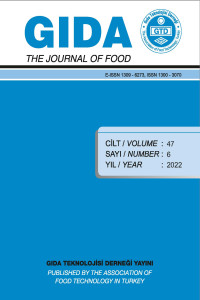Öz
Anahtar Kelimeler
lauric acid emulsifier oleogel rheology microstructure stability
Proje Numarası
217O094
Kaynakça
- AOCS. (2012). AOCS Official Method Cj 2-95. X-ray diffraction analysis of fats. Official Methods and Recommended Practices of the AOCS, 6th Ed. 2011-2012 Methods and Additions and Revisions.
- Co, E.D., Marangoni, A.G. (2012). Organogels: An alternative edible oil-structing method. Journal of the American Oil Chemists’ Society, 89: 749-780. doi 10.1007/s11746-012-2049-3.
- Davidovich-Pinhas, M. (2016). Oleogels: a promising tool for delivery of hydrophobic bioactive molecules. Therapeutic Delivery, 7 (1), 1–3. https://doi.org/10.4155/tde.15.83.
- Eisa, A.H., Laufer, S., Rosen-Kligvasser, J., Davidovich-Pinhas, M. (2020). Stabilization of ethyl-cellulose oleogel network using lauric acid. European Journal of Lipid Science and Technology, 122 (1900044): 2-10. https://doi.org/10.1002/ejlt.201900044.
- Harris, L., Rosen-Kligvasser, J., Davidovich-Pinhas, M. (2019). Gelation of oil using combination of different free fatty acids. Food Structure, 21: 100121-100131. https://doi.org/10.1016/j.foostr.2019.100121.
- Hwang, H-S. (2020). A critical review on structures, health effects, oxidative stability, and sensory properties of oleogels. Biocatalysis and Agricultural Biotechnology, 26: 101657. https://doi.org/10.1016/j.bcab.2020.101657.
- Keskin Uslu, E., Yılmaz, E. (2019). Protein emülsiyon ağıyla yapılandırılmış oleojeller. Akademik Gıda, 17(3), 410-416. https://doi.org/10.24323/akademik-gida.647730.
- Keskin Uslu, E., Yılmaz, E. (2021). Production and characterization of oleogels with tallow and partially hydrolyzed tallow as organogelators. Grasas Y Aceties, 72 (1): 388-398. https://doi.org/10.3989/gya.1031192.
- Mattice K.D., Marangoni A.G. (2018). Insights into wax crystal networks in oleogels. In: Edible Oil Structuring Concepts, Methods and Applications. Patel, A.R. (chief ed.), Volume1, Royal Society Chemistry, Chambridge, pp. 71-95.
- Mezger, T.G. (2014). Applied Rheology. Volume1, Anton Paar GmbH, Austria, 191p. ISBN:10-3950401601.
- Minitab. (2010). Minitab Statistical Software (Version 16.1). Minitab, Inc., State College, Pennsylvania, US.
- O'Brien, R.D. (2004). Fats and Oils: Formulating and Processing For Applications. 2nd Edition, CRC press LLC, Boca Raton, Florida, 574 p. ISBN: 0-8493-1599-9.
- Sagiri, S.S., Samateh, M., John, G. (2018). Biobased molecular structuring agents. In: Edible Oil Structuring: Concept, Methods and Applications, Patel, A.R. (chief ed.), Volume1, Royal Society Chemistry, Chambridge, pp. 25-52.
- Singh, A., Auzanneau, F.I., Rogers, M.A. (2017). Advances in edible oleogel technologies – A decade in review. Food Research International, 97: 307–317. https://doi.org/10.1016/j.foodres.2017.04.022.
- Uvanesh, K., Sagiri, S.S., Senthilguru, K., Pramanik, K., Banerjee, I., Arfat S., Al-Zahrani, M., Pal, K. (2016). Effect of Span 60 on the microstructure, crystallization kinetics, and mechanical properties of stearic acid oleogels: an in-depth analysis. Journal of Food Science, 81(2), E380-E387. https://doi.org/10.1111/1750-3841.13170.
Öz
Destekleyen Kurum
TÜBİTAK
Proje Numarası
217O094
Teşekkür
Bu çalışma, Türkiye Bilimsel ve Teknik Araştırma (TÜBİTAK) kurumu (Proje No: TOVAG-217O094) tarafından desteklenmiştir.
Kaynakça
- AOCS. (2012). AOCS Official Method Cj 2-95. X-ray diffraction analysis of fats. Official Methods and Recommended Practices of the AOCS, 6th Ed. 2011-2012 Methods and Additions and Revisions.
- Co, E.D., Marangoni, A.G. (2012). Organogels: An alternative edible oil-structing method. Journal of the American Oil Chemists’ Society, 89: 749-780. doi 10.1007/s11746-012-2049-3.
- Davidovich-Pinhas, M. (2016). Oleogels: a promising tool for delivery of hydrophobic bioactive molecules. Therapeutic Delivery, 7 (1), 1–3. https://doi.org/10.4155/tde.15.83.
- Eisa, A.H., Laufer, S., Rosen-Kligvasser, J., Davidovich-Pinhas, M. (2020). Stabilization of ethyl-cellulose oleogel network using lauric acid. European Journal of Lipid Science and Technology, 122 (1900044): 2-10. https://doi.org/10.1002/ejlt.201900044.
- Harris, L., Rosen-Kligvasser, J., Davidovich-Pinhas, M. (2019). Gelation of oil using combination of different free fatty acids. Food Structure, 21: 100121-100131. https://doi.org/10.1016/j.foostr.2019.100121.
- Hwang, H-S. (2020). A critical review on structures, health effects, oxidative stability, and sensory properties of oleogels. Biocatalysis and Agricultural Biotechnology, 26: 101657. https://doi.org/10.1016/j.bcab.2020.101657.
- Keskin Uslu, E., Yılmaz, E. (2019). Protein emülsiyon ağıyla yapılandırılmış oleojeller. Akademik Gıda, 17(3), 410-416. https://doi.org/10.24323/akademik-gida.647730.
- Keskin Uslu, E., Yılmaz, E. (2021). Production and characterization of oleogels with tallow and partially hydrolyzed tallow as organogelators. Grasas Y Aceties, 72 (1): 388-398. https://doi.org/10.3989/gya.1031192.
- Mattice K.D., Marangoni A.G. (2018). Insights into wax crystal networks in oleogels. In: Edible Oil Structuring Concepts, Methods and Applications. Patel, A.R. (chief ed.), Volume1, Royal Society Chemistry, Chambridge, pp. 71-95.
- Mezger, T.G. (2014). Applied Rheology. Volume1, Anton Paar GmbH, Austria, 191p. ISBN:10-3950401601.
- Minitab. (2010). Minitab Statistical Software (Version 16.1). Minitab, Inc., State College, Pennsylvania, US.
- O'Brien, R.D. (2004). Fats and Oils: Formulating and Processing For Applications. 2nd Edition, CRC press LLC, Boca Raton, Florida, 574 p. ISBN: 0-8493-1599-9.
- Sagiri, S.S., Samateh, M., John, G. (2018). Biobased molecular structuring agents. In: Edible Oil Structuring: Concept, Methods and Applications, Patel, A.R. (chief ed.), Volume1, Royal Society Chemistry, Chambridge, pp. 25-52.
- Singh, A., Auzanneau, F.I., Rogers, M.A. (2017). Advances in edible oleogel technologies – A decade in review. Food Research International, 97: 307–317. https://doi.org/10.1016/j.foodres.2017.04.022.
- Uvanesh, K., Sagiri, S.S., Senthilguru, K., Pramanik, K., Banerjee, I., Arfat S., Al-Zahrani, M., Pal, K. (2016). Effect of Span 60 on the microstructure, crystallization kinetics, and mechanical properties of stearic acid oleogels: an in-depth analysis. Journal of Food Science, 81(2), E380-E387. https://doi.org/10.1111/1750-3841.13170.
Ayrıntılar
| Birincil Dil | Türkçe |
|---|---|
| Konular | Gıda Mühendisliği |
| Bölüm | Makaleler |
| Yazarlar | |
| Proje Numarası | 217O094 |
| Erken Görünüm Tarihi | 19 Ekim 2022 |
| Yayımlanma Tarihi | 15 Aralık 2022 |
| Yayımlandığı Sayı | Yıl 2022 Cilt: 47 Sayı: 6 |


